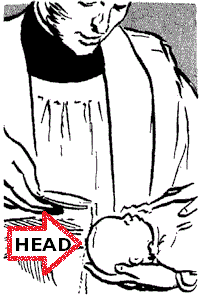 From a priestly reader…
From a priestly reader…
QUAERITUR:
I am a parish priest who often does an Ad Orientem Novus Ordo Mass. I was approached by a family asking for a baptism using the Extraordinary Form. I am happy to do so, given the evident power of the prayers, but then they also wondered if it could be done using an English translation they showed me [from sanctamissa.org]. Do you know if that is licet?
First, thank you for being open to doing this! I must warn you, however, once you start using the traditional rite you are probably going to want to continue to use it all the time.
To the question, yes, much of the older, traditional form of the Latin Church’s rite of baptism can be done in English. This is useful and often disarming for some people in attendance.
However, when permission was given way back when for some vernacular languages to be used for baptism, certain parts had to be done in Latin. For example, the exorcisms and blessings of salt and water must be in Latin, the exorcism of the one to be baptized, the form of the sacrament, the anointings must be in Latin. That’s what was in force in 1962 and that’s what Summorum Pontificum designates as our reference point. Hence, in 1962 that’s what we could do, so that’s what we do today.
Some editions of the Collectio Rituum (a small compilation of the most used items in the more comprehensive Rituale Romanum) have this laid out clearly so that you know which parts can be English and which must be Latin, and also provide the English even of the part that must be in Latin.
There are, or at least were, very good booklets for the participants in the rite published by Angelus Press. At the time of this writing, I am in a moving vehicle and can’t hunt it up.
I think you and your people will be edified by the older, traditional form of baptism which is richer in its symbols. Thanks to the provisions of Summorum Pontificum 9 § 1 priests can also use the older Rituale Romanum for this foundational sacrament.
All Roman priests should be familiar with the older books and their Roman rites. Don’t you think that priests should know the rite for which they were ordained?


































My twins were baptised using the EF, but the priest said the water-pouring words of ‘I baptise you in the name of…’ in English by accident (I only half noticed at the time, as I was trying not to drop a wriggling toddler from one hand and white garments, candles and a booklet from the other, but this post has jogged my memory). He is an excellent priest – we are truly blessed to have him in our midst – who knows the rubrics well, but I think he may have got distracted on this occasion by the logistical difficulties of the situation – twins, with godparents inexperienced at holding babies, etc.
But now I am worried. Was the baptism valid?
[So long as he said the whole and proper formula in English, yes, it was valid. Not to worry. ]
That explains a lot. Thanks! I was baptized post-VII, but (according to a quick google search) before the complete introduction of the changes. My baby book says that I was baptized in Latin and English, but my mom was only a few years into being Catholic so she couldn’t say exactly what that meant. Considering that the priest was a decent guy not given to running off half-cocked, it sounds like I got what today would be called the Extraordinary Form, with the key parts in Latin and the rest in English. Thanks for the explanation.
Am I correct in thinking that baptism in the old rite may only be administered by a priest and not by a permanent deacon?
[A deacon can do it, but with some changes to the rite.]
Pingback: THVRSDAY EXTRA – Big Pulpit